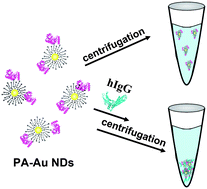Protein A-conjugated luminescent gold nanodots as a label-free assay for immunoglobulin G in plasma†
Abstract
We have employed

* Corresponding authors
a
Department of Chemistry, National Taiwan University, 1, Section 4, Roosevelt Road, Taipei, Taiwan
E-mail:
changht@ntu.edu.tw
Fax: +886-2-3366-1171
Tel: +886-2-3366-1171
b
Institute of Bioscience and Biotechnology, National Taiwan Ocean University, 2, Beining Road, Keelung, Taiwan
E-mail:
huanging@ntou.edu.tw
Fax: +886-2-2462-2320
Tel: +886-2-2462-2192 ext 5517
c Center for Marine Bioenvironment and Biotechnology, National Taiwan Ocean University, Keelung, Taiwan
We have employed

 Please wait while we load your content...
Something went wrong. Try again?
Please wait while we load your content...
Something went wrong. Try again?
Y. Shiang, C. Lin, C. Huang and H. Chang, Analyst, 2011, 136, 1177 DOI: 10.1039/C0AN00889C
To request permission to reproduce material from this article, please go to the Copyright Clearance Center request page.
If you are an author contributing to an RSC publication, you do not need to request permission provided correct acknowledgement is given.
If you are the author of this article, you do not need to request permission to reproduce figures and diagrams provided correct acknowledgement is given. If you want to reproduce the whole article in a third-party publication (excluding your thesis/dissertation for which permission is not required) please go to the Copyright Clearance Center request page.
Read more about how to correctly acknowledge RSC content.
 Fetching data from CrossRef.
Fetching data from CrossRef.
This may take some time to load.
Loading related content
